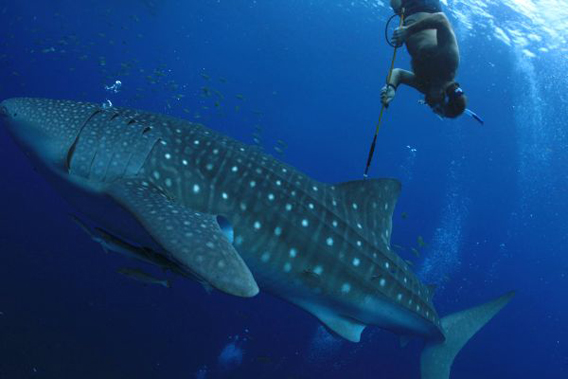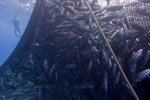
Brent Stewart tags a whale shark with a radio-frequency identification (RFID) tag in Indonesia. Photo: © CI/Mark Erdmann.
Researchers have a caught a juvenile—though still massive—whale shark on camera sucking fish out of a hole in an Indonesian fishing net. Posted on YouTube.com, the video has gone viral and has been viewed by 1.2 million people to date. The footage was captured during a program to tag 30 whale sharks (Rhincodon typus) in Indonesia’s Cendrawasih Bay National Marine Park in order to learn more about the world’s largest fish.
“These massive fish can grow to nearly 50-feet in length,” explains Greg Stone with Conservation International (CI). “In order to support that massive body, they have to consume tons of plankton or small fish a day. The behavior developed by the sharks in Cenderwasih Bay is a novel a behavioral adaptation to meeting that mark.”
The whale sharks in the area have learned to follow local fishermen for a meal, however this practice can also be dangerous for the giants. Whale sharks sometimes become entrapped in nets and require rescue (as shown in a second video). Conservationists are now working with fishermen to modify the nets’ designs in order to let whale sharks escape.
Indonesian fishermen don’t begrudge the whale sharks their take, according to marine biologist Mark Erdmann: “The bagan fishers in Cendrawasih Bay, as in most areas of Indonesia, regard the whale sharks as good luck and as friends.”
Stone, Ermann, and other researchers are tagging whale sharks in the park with radio-frequency identification tags. This technology allows any future researcher to identify an individual whale shark by scanning them with a receiver wand. The scientists hope the radio transmitters will allow researchers to estimate the population in the area given that the giant fish are easily accessible when they congregate at the fishermen’s nets.
The whale shark is listed as Vulnerable by the IUCN Red List—and in decline—due to ongoing hunting in some countries, though many nations have banned the practice.
Conservation International is working on this program along with WWF-Indonesia, Hubbs Sea World Research Institute and the State University of Papua.
Related articles
Bad science journalism: articles spread misinformation about whale sharks

(07/09/2012) The death of one of the world’s largest recorded whale sharks (Rhincodon typus) in the Arabian Sea provoked a sudden global interest in these massive shark. Weighing 14.5 tons, the fish in question made ‘whale shark ‘whale shark’ the number 3 top search in Google Trends on the day the news hit. But, according to a new study in mongabay.com’s open access journal Tropical Conservation Science, more than half the reports filed by journalists were “factually wrong.”
World failing to meet promises on the oceans

(06/14/2012) Despite a slew of past pledges and agreements, the world’s governments have made little to no progress on improving management and conservation in the oceans, according to a new paper in Science. The paper is released just as the world leaders are descending on Rio de Janeiro for Rio+20, or the UN Summit on Sustainable Development, where one of the most watched issues is expected to be ocean policy, in part because the summit is expected to make little headway on other global environmental issues such as climate change and deforestation. But the new Science paper warns that past pledges on marine conservation have moved too slowly or stagnated entirely.
Manta rays tracked by satellite
(05/11/2012) Satellite tracking technology has revealed new insights into the behavior of manta rays, reports the Wildlife Conservation Society (WCS). The findings are published in this week’s issue of the journal PLoS.